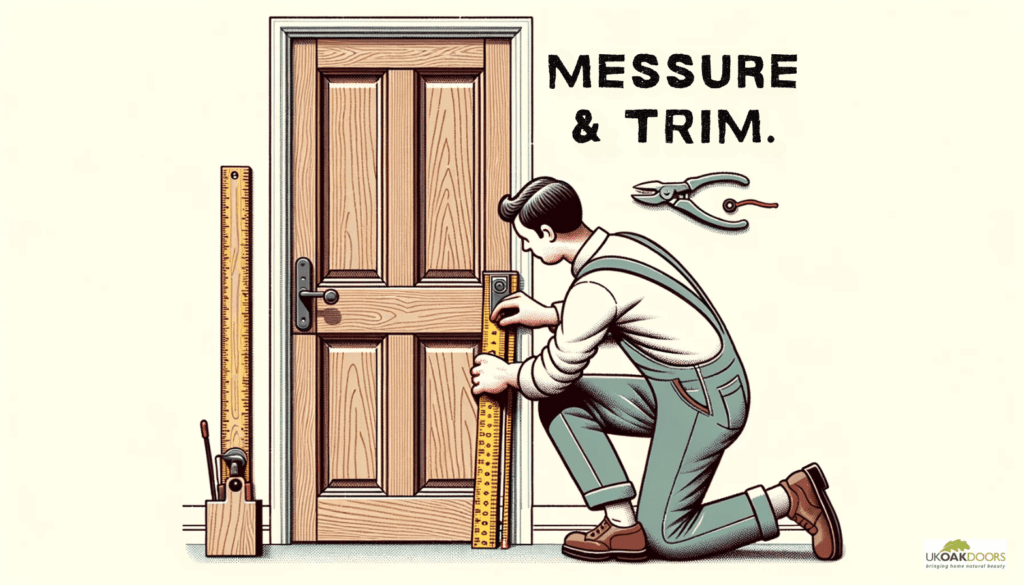Key Takeaways
| Key Points | Description |
|---|---|
| Material Types | Explored the use of woods like oak, pine, mahogany, and their benefits. |
| Design Styles | Highlighted styles such as flush, panel (e.g., 3-panel, 5-panel), and glazed doors. |
| Installation Tips | Emphasized the importance of precise measurements and considering professional installation if unsure. |
| Maintenance Insights | Discussed regular waxing or polishing and how to handle temperature-induced expansion or contraction. |
| Benefits of Solid Wood Doors | Durable, soundproof, visually appealing, and can enhance property value. |
| Drawbacks of Solid Wood Doors | Might be more expensive, requires consistent maintenance, and can be sensitive to extreme temperatures. |
| Case Studies | Reviewed real-life examples of homes that integrated solid wood internal doors and the transformation it brought. |
| Choosing the Right Door | Advised on considering architectural style, budget, and room-specific needs. |
| FAQs | Addressed common questions around benefits, drawbacks, types, selection process, and installation. |
Introduction
Solid wood internal doors are a staple in many homes, bringing a sense of warmth, tradition, and durability. Often lauded for their robust construction and timeless appeal, these doors serve as more than just a barrier between rooms; they're a statement of style and quality. But what exactly are they, and why do they hold such an esteemed place in interior design? What are solid wood internal doors? At its core, a solid wood internal door is crafted entirely from a single type of wood, be it oak, walnut, or pine. Unlike veneered or engineered doors, which may contain layers of different materials, solid wood doors maintain a consistent wooden structure throughout. Why are solid wood internal doors popular? The popularity of solid wood doors can be attributed to their rich texture, aesthetic versatility, and unparalleled durability. They have an innate ability to complement a range of home styles, from the rustic charm of a countryside cottage to the sophisticated elegance of a modern loft. Benefits of solid wood internal doors:
- Durability: With proper maintenance, these doors can last for decades, resisting wear and tear.
- Aesthetic Appeal: Their natural grain patterns and hues enhance the overall decor.
- Soundproofing: The dense nature of solid wood offers better acoustic insulation.
- Customisability: Can be painted, stained, or carved to suit individual preferences.
Drawbacks of solid wood internal doors:
- Cost: They tend to be more expensive than their hollow core or engineered counterparts.
- Maintenance: Require periodic resealing or refinishing to retain their lustre.
- Weight: Being solid, they can be heavier and might need sturdy hinges.
Types of solid wood internal doors: From traditional Victorian doors to sleek and modern styles, the range is vast. Whether panelled, glazed, or french-styled, there's a design for every home. Who should buy solid wood internal doors? For homeowners seeking longevity, sound insulation, and a touch of luxury, these doors are an ideal choice. They're particularly apt for spaces where durability and aesthetics are paramount.

How to choose the right solid wood internal doors for your home: Consider factors like the type of wood, design compatibility with your home, your budget, and the door's intended location. For instance, oak doors, available at UK Oak Doors, are versatile and suit a myriad of interiors. List of Considerations:
- Wood Type: Oak, Pine, Walnut.
- Design: Panelled, Glazed, French.
- Budget: Set a range before shopping.
- Location: Main entrance, bedroom, bathroom.
Comparing Solid Wood Internal Doors to Other Types of Internal Doors

Solid Wood Internal Doors vs. Hollow Core Internal Doors
Solid wood internal doors, as the name implies, are crafted entirely from a single piece of wood. Their solid construction gives them a weighty feel and is often associated with quality and durability. The main advantages of these doors include:
- Durability: Less prone to damage, ensuring a longer lifespan.
- Soundproofing: Provides superior noise insulation.
- Feel: Offers a premium, weighty feel when opened or closed.
On the other hand, hollow core doors are constructed with a hollow centre, typically filled with a honeycomb structure. This makes them lighter and more affordable. However, they come with downsides:
- Durability: More prone to dents and damage.
- Soundproofing: Not as effective in blocking out noise.
- Feel: Tends to feel less solid and premium.
When considering a purchase, solid wood internal doors often come at a higher initial cost but offer long-term benefits in durability and aesthetics.
Solid Wood Internal Doors vs. Engineered Wood Internal Doors
Engineered wood doors are made from a combination of wood fibres, adhesives, and veneers. This construction offers a balance between cost, durability, and appearance. Benefits of engineered wood doors include:
- Stability: Less susceptible to warping due to temperature changes.
- Cost: Typically more affordable than solid wood doors.
- Appearance: Can be designed to mimic the appearance of solid wood.
However, solid wood doors offer unmatched authenticity and can be refinished multiple times, ensuring they look pristine for years.
Solid Wood Internal Doors vs. Fire Doors
Fire doors play a crucial role in safety, designed to resist the spread of fire and smoke. While solid wood can be used in the construction of fire doors, it's the door's core and additional fire-resistant materials that determine its effectiveness. If safety is a top priority, always check the fire rating of the door, regardless of its material.
Solid Wood Internal Doors vs. Acoustic Doors
Acoustic doors are specially designed for soundproofing. While the dense nature of solid wood offers good natural soundproofing, acoustic doors contain additional materials to maximise this effect. For rooms where noise isolation is essential, such as a home cinema, it's worth exploring dedicated acoustic doors.
Comparison of Solid Wood Internal Doors to Other Types
| Feature/Type | Solid Wood Internal Doors | Hollow Core Internal Doors | Engineered Wood Internal Doors | Fire Doors | Acoustic Doors |
|---|---|---|---|---|---|
| Material Construction | Single piece of wood | Hollow centre | Wood fibres, adhesives, veneers | Varies (often includes fire-resistant materials) | Varies with additional soundproofing materials |
| Durability | High | Moderate to Low | Moderate to High | High | High |
| Soundproofing | High | Low | Moderate | Moderate | Very High |
| Appearance | Authentic | Less authentic | Can mimic solid wood | Varies | Varies |
| Cost | Higher initial cost | More affordable | Balanced cost | Varies | Typically higher |
| Susceptibility to Warping | Moderate | Moderate | Less susceptible | Moderate | Moderate |
| Ability to be Refinished | Multiple times | Limited | Limited | Limited | Limited |
| Best Use | Aesthetic appeal, longevity | Budget-friendly solutions | Balance of cost and appearance | Safety | Noise isolation |
Choosing and Maintaining Solid Wood Internal Doors
Choosing the Right Type of Solid Wood for Your Internal Doors
The choice of wood type plays a pivotal role in determining the door's appearance, durability, and price. Popular options include:
- Oak: Known for its durability and aesthetic appeal, oak doors offer a timeless look and resist wear and tear.
- Walnut: Dark and rich, walnut doors add a touch of luxury to any room.
- Pine: A more affordable choice, pine doors have a light colour that's perfect for painting.
- Mahogany: Celebrated for its rich red and brown hues, mahogany doors exude elegance.
Choosing the Right Style of Solid Wood Internal Doors
From traditional Victorian designs to modern minimalist looks, there's a style for every home:
- Panel Doors: Ranging from 2-panel to 6-panel designs, these are versatile and suit various interiors.
- Glazed Doors: Incorporate glass panels, allowing natural light flow while maintaining privacy.
- Bifold Doors: Ideal for space-saving, they fold in sections and are perfect for closets or room dividers.
- Barn Doors: Rustic and charming, these slide along an overhead track.
Choosing the Right Size of Solid Wood Internal Doors
Measuring is crucial to ensure a snug fit:
- Measure the door frame's height and width.
- Remember to account for any carpet or flooring.
- For non-standard sizes, consider bespoke doors tailored to your measurements.
Measuring and Fitting Solid Wood Internal Doors
After purchasing the perfect door, fitting is the next step:
- Ensure the door fits snugly, with a slight gap for hinges.
- For doors with a specific top and bottom, mark accordingly.
- Use wedges to keep the door level when fitting.
Maintaining Solid Wood Internal Doors
To keep your door looking its best:
- Cleaning: Wipe down with a damp cloth, avoiding excessive moisture.
- Protection: Consider using oils or waxes for added protection.
- Regular Checks: Inspect for any signs of wear, damage, or misalignment.
By selecting the right wood type, style, and size, and following these maintenance tips, homeowners can ensure their solid wood internal doors remain a centrepiece in their homes for years to come.
Case Studies: Solid Wood Internal Doors in Real Homes
Case Study 1: The Modern City Apartment
Homeowner: Sarah, a young professional living in a bustling city centre. Choice of Door: Modern solid oak doors with glazed panels. Why It Works: Sarah's apartment, with its open-plan layout and contemporary design, demanded a door that would seamlessly blend with the interiors while allowing light to permeate throughout. The glazed oak door not only matched her stylish décor but also created an illusion of space, making her apartment appear larger and more inviting.
Case Study 2: The Countryside Cottage
Homeowner: John and Lucy, a retired couple relishing the quiet life. Choice of Door: Traditional barn doors in solid pine. Why It Works: Nestled amidst green pastures, their quaint cottage, with its exposed beams and stone walls, needed a door that would complement its rustic charm. The barn doors became an instant fit, exuding a timeless appeal that resonated with the home's heritage.
Case Study 3: The Victorian Townhouse
Homeowner: Alex and Mia, a young family with two kids. Choice of Door: Victorian panel doors in walnut. Why It Works: Their refurbished townhouse, adorned with high ceilings and ornate cornices, required a door reminiscent of its Victorian era. The walnut panel door, with its intricate details, not only elevated the aesthetic appeal but also provided the needed privacy for various rooms.
Conclusion
Solid wood internal doors are about more than just function; they set the ambiance of a home. Their timeless elegance paired with durability makes them a prime choice for various home styles. From modern to barn designs, there's a wood door for every taste. Beyond looks, their insulation properties and long-lasting nature, with the right care, make them a valuable investment. In essence, solid wood doors are a blend of beauty and practicality, deserving a place in every home.
Frequently Asked Questions (FAQs) on Solid Wood Internal Doors
Q: What are the main benefits of solid wood internal doors?
A: Solid wood internal doors offer several advantages. They:
- Are more durable and long-lasting.
- Provide superior insulation and soundproofing.
- Enhance the visual appeal of your interiors.
- Can potentially increase your property value.
Q: What are the main drawbacks of solid wood internal doors?
A: While they have many advantages, there are also some considerations:
- They tend to be pricier compared to other door types.
- Require consistent maintenance like waxing or polishing.
- Might expand or contract with extreme temperature changes.
Q: What are the different types of solid wood internal doors?
A: These doors come in diverse styles:
- Flush doors
- Panel doors, such as 2-panel or 6-panel variants.
- Glazed doors
- Wood species like oak, pine, and mahogany.
Q: How do I choose the right solid wood internal doors for my home?
A: To select the ideal doors, consider:
- Your home's architectural style.
- Your allocated budget.
- Room-specific needs, e.g., fire doors for safety.
Q: How do I measure and fit solid wood internal doors?
A: Ensure precise measurements of your doorways before purchasing. Gather the required tools and familiarise yourself with the fitting process. If uncertain, enlist the expertise of a skilled carpenter or door fitter.


